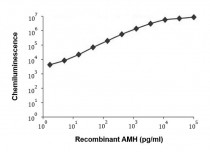ARG11105
anti-AMH antibody [AMH41cc]
anti-AMH antibody [AMH41cc] for Chemiluminescence immunoassay,ELISA,IHC-Formalin-fixed paraffin-embedded sections,Purification,Western blot and Human
Overview
| Product Description | Mouse Monoclonal antibody [AMH41cc] recognizes AMH |
|---|---|
| Tested Reactivity | Hu |
| Tested Application | CLIA, ELISA, IHC-P, Puri, WB |
| Specificity | Mullerian hormone |
| Host | Mouse |
| Clonality | Monoclonal |
| Clone | AMH41cc |
| Isotype | IgG2a |
| Target Name | AMH |
| Antigen Species | Human |
| Immunogen | Recombinant Human AMH. |
| Conjugation | Un-conjugated |
| Alternate Names | AMH; Muellerian-inhibiting substance; MIF; Anti-Muellerian hormone; Muellerian-inhibiting factor; MIS |
Application Instructions
| Application Suggestion |
|
||||||||||||
|---|---|---|---|---|---|---|---|---|---|---|---|---|---|
| Application Note | Sandwich ELISA (Capture antibody - Detection antibody): ARG11106 - ARG11105 * The dilutions indicate recommended starting dilutions and the optimal dilutions or concentrations should be determined by the scientist. |
Properties
| Form | Liquid |
|---|---|
| Purification | Purification with Protein A. |
| Buffer | PBS (pH 7.4) and 0.09% Sodium azide. |
| Preservative | 0.09% Sodium azide |
| Storage Instruction | For continuous use, store undiluted antibody at 2-8°C for up to a week. For long-term storage, aliquot and store at -20°C or below. Storage in frost free freezers is not recommended. Avoid repeated freeze/thaw cycles. Suggest spin the vial prior to opening. The antibody solution should be gently mixed before use. |
| Note | For laboratory research only, not for drug, diagnostic or other use. |
Bioinformation
| Database Links | |
|---|---|
| Gene Symbol | AMH |
| Gene Full Name | anti-Mullerian hormone |
| Background | This gene encodes a secreted ligand of the TGF-beta (transforming growth factor-beta) superfamily of proteins. Ligands of this family bind various TGF-beta receptors leading to recruitment and activation of SMAD family transcription factors that regulate gene expression. The encoded preproprotein is proteolytically processed to generate N- and C-terminal cleavage products that homodimerize and associate to form a biologically active noncovalent complex. This complex binds to the anti-Mullerian hormone receptor type 2 and causes the regression of Mullerian ducts in the male embryo that would otherwise differentiate into the uterus and fallopian tubes. This protein also plays a role in Leydig cell differentiation and function and follicular development in adult females. Mutations in this gene result in persistent Mullerian duct syndrome. [provided by RefSeq, Jul 2016] |
| Function | This glycoprotein, produced by the Sertoli cells of the testis, causes regression of the Muellerian duct. It is also able to inhibit the growth of tumors derived from tissues of Muellerian duct origin. [UniProt] |
| Cellular Localization | Secreted. [UniProt] |
| Calculated MW | 59 kDa |
Images (1) Click the Picture to Zoom In
-
ARG11105 anti-AMH antibody [AMH41cc] CLIA image
Calibration curves for recombinant AMH in sandwich CLIA using ARG11106 - ARG11105 (Capture antibody - Detection antibody). The label used was streptavidin/HRP. Recombinant antigen was diluted with PBS containing 0.1% Tween 20 and 75 mg/ml BSA.






